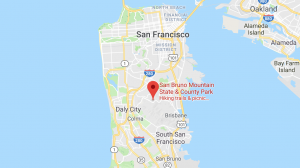Date: 3/22/18
Location: San Bruno, CA , 37.6969° N, 122.4338° W, elevation 1314 ft.
Site Description:
San Bruno State Park is picturesque with a view of the SF bay area. The area is mostly bedrock and contains diverse micro-environments of coastal scrub and grassland communities. Species such as the Pacific manzanita, Montara manzanita, San Bruno Mountain Manzanita and the Franciscan wallflower are abundant here.
Species Descriptions:
Pictured above is the species Sanicula arctopoides, also known as “Yellow mats.” They are part of the Apiaceae family and are a California native. It is a perennial to annual herb, with simple, generally alternate, palmately dissected leaves that are coarsely toothed. Stem is generally spreading to erect. Peduncle inflorescence with yellow bisexual flowers. Calyx lobes fused proximal to middle, yellow corolla. Typically found in temperate climates, coastal areas and headlands.
Pictured above is the species Erysimum franciscanum, which is the “Franciscan wallflower.” It is part of the Brassicaceae family and is a rare California native. It is a subshrub and has a weedy leaf like look with woody stem. It has a basal rosette, dentated, entire, oblanceolate leaves. It has free white petals, and the flowers form a tube that become free at the end. Six stamens, 4 long and 2 short. Typically found in Mediterranean climates, serpentine soils and coastal scrub areas.
Pictured above is Lobularia maritima, which is also known as “Sweet asylum.” This is apart of the Brassicaceae family and is an invasive species. It is annual, perennial herb, with simple/alternate leaves. It is entire, not lobed at base. Flowers are bisexual, radial, with 4 sepals and 4 petals. They are generally white or purple. 6 stamen, 4 long and 2 short. Stem is erect and branched from base. These flowers are typically found in disturbed areas.
Narrative:
This was one of my favorite field trips because we got to go to InnOut after. We first went up higher in the trails to go over some plants and review before our field quiz. We spent a great deal of time looking at plants that we had seen before and adding in a handful that were new. It was definitely helpful to note which ones would be on the quiz, and it helped me to see which plants I knew and which ones I had a hard time with. We briefly scouted plants in a more grassy area near the bottom of the park. After our hard work, we went to In n out and got to feast as a class!







